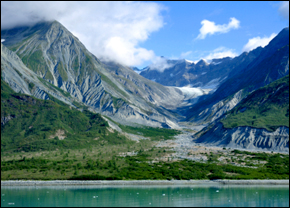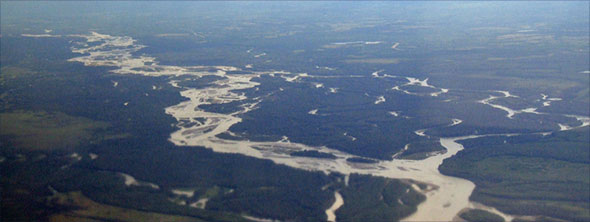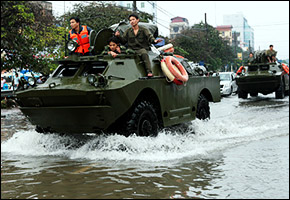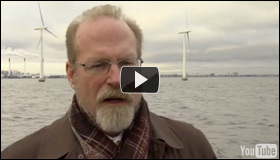Analysis: Obama Takes Copenhagen Stage While Palin Sits on Thinning Ice
 Steven Solomon, author of the forthcoming book, WATER: The Epic Struggle for Wealth, Power, and Civilization, examines water’s integral role as a planetary climate regulator. Solomon sounds a warning for climate change deniers including Sarah Palin, as well as for those leaders, like President Barack Obama, who have been slow to act.
Steven Solomon, author of the forthcoming book, WATER: The Epic Struggle for Wealth, Power, and Civilization, examines water’s integral role as a planetary climate regulator. Solomon sounds a warning for climate change deniers including Sarah Palin, as well as for those leaders, like President Barack Obama, who have been slow to act.
By Steven Solomon
special to Circle of Blue
With America’s national debate on global warming going bipolar between President Obama’s grand entrance at Copenhagen and the surreality of Sarah from Alaska going rogue on world environmental science by championing the climate deniers, those committed to doing the planet’s serious business should stay focused on one, often overlooked but trackable key factor of climate change—the pivotal role of water. It is through water that global warming destabilizes civilized societies. At Copenhagen last week, Bill McKibben of 350.org warned of a looming, water-related doomsday tipping point that could render future climate change efforts moot–if warming temperatures thaw the permanently frozen Arctic soils to release its methane greenhouse gasses.
Water’s central role was colorfully highlighted in the run up to Copenhagen by cabinet members from the sea level Maldives islands and mountainous Nepal who separately held meetings underwater and at the base of Mount Everest’s shrinking glaciers. They are desperate because they are on the front lines of the global warming battle. Along with the billions of other water-distressed people around the planet, climate change is exacerbating today’s mounting crisis of freshwater scarcity by radically altering hydrologic patterns to produce overwhelming flooding, droughts, storms, rising coastal sea levels, as well as the unprecedented melting of Arctic icecaps and mountain glaciers visible in Sarah’s own backyard. While the impacts are complex, they fall unevenly and are further dividing human society—with water rich regions generally getting wetter and arid ones drier.
With the growing scarcity of irreplaceable freshwater overtaking oil as a critical driver of world affairs, as narrated in my forthcoming WATER: The Epic Struggle for Wealth, Power, and Civilization (HarperCollins January 5, 2010), no climate change policy can succeed without parallel policies that help water-stressed partner societies endure the destabilizing shocks to their existing water supplies and infrastructures. Climate change thus makes global citizens of us all.
Not even remote Alaska will be spared the repercussions of failure. Temperatures are rising fastest in the high mountains, accelerating the melting of river-replenishing glaciers from the Himalayas to the Andes, and threatening the lives of the 2 billion people that depend upon them for food, industry, and drink. With global integration, there is symmetrical feedback between the vanishing glaciers and dry river beds and the blowing up of New York’s Twin Towers. Consider what will happen in water-distressed Pakistan—nuclear-armed, terrorist-besieged, overpopulated, heavily irrigation-dependent, and already politically unstable—when its single water lifeline, the Indus River, loses a third of its flow from the disappearance of its glacier water source.
Water-rich, temperate southeastern America’s recent episode of rare, prolonged drought followed by intense rainfall and deadly floods was but a mild taste of the pattern that is playing out on much more intense, larger, tragic scales in the freshwater distressed parts of the planet. In places like monsoonal India, Bangladesh, and in Darfur, the destruction of crop and grazing land by epic floods and droughts is spreading horrors like famine, sale of children, disease outbreaks, and a totally new, burgeoning phenomenon in history—climate refugees on a scale of multi-millions.
Drill, Baby, Drill Sarah reminds me of those reckless Wall Street home loan bankers when she frets about sacrificing short term energy profits by reducing our carbon footprint instead of prudently worrying about the cumulative costs of systemic meltdown in view dead ahead. All Copenhagen climateers know that low carbon energy technologies are critical to controlling global warming. Yet few fully appreciate that ever since the invention of the waterwheel over 2,000 years ago our water and energy infrastructures have evolved into inseparable twins. Energy production is very thirsty—40% of all U.S. freshwater withdrawals from rivers and lakes is used by thermoelectric power plants—while water consumes lots of energy to perform its myriad economic functions. Thus the water footprint embedded in any unit of energy is another bedeviling factor of global warming solutions.
The carbon capture and underground storage (CCS) solutions that so many governments are depending on to meet their carbon reducing commitments, for example, require 45% to 90% more water to remove carbon dioxide. In 2008 China halted its big coal to liquids projects not because of environmental concerns but because its water demands—up to 5 times more than conventional oil production—were simply too great to satisfy in its arid northern coal fields. Fear of contaminating drinking water supplies has scotched projects for hydraulic fracturing of deep shale deposits to produce natural gases, and raised doubts whether scrubbing coal-fired chimneys of air pollutants may not simply be exchanging one form of pollution for another.
Water’s central role as a planetary climate regulator has thus far saved the Earth from heating up much faster than suggested from the alarming one-third increase in atmospheric carbon dioxide to 387ppm (the highest level in 420,000 years) from the day James Watt’s steam engine inaugurated the Industrial Era. But there is a limit to its molecular capacity to absorb vast amounts of heat in the oceans without heating up itself and to reflect solar rays off ice sheets back into space.
It is what President Obama decides to do when all the world’s eyes are upon him at Copenhagen, of course, that matters for the long-term well-being of the planet. Sarah and the climate deniers can ignore the science of global warming if they want to, but hopefully a wiser Obama knows that the rich, temperate world can’t isolate itself from the global feedback loops of disease, wars, terrorism, and environmental crises—and that the triggering agent is often related to water.
Within a decade there are likely to be 150 million restive climate migrants roaming the globe. They won’t go quietly, wherever they go. Many of them might even immigrate to Sarah’s Alaska, as the permafrost thaws.
Steven Solomon has written for The New York Times, BusinessWeek, The Economist, Forbes, and Esquire. He is author of WATER: The Epic Struggle for Wealth, Power, and Civilization published by HarperCollins. Read more from Solomon’s water blog here. A version of this editorial appeared in the Huffington Post.
Circle of Blue provides relevant, reliable, and actionable on-the-ground information about the world’s resource crises.







Leave a Reply
Want to join the discussion?Feel free to contribute!